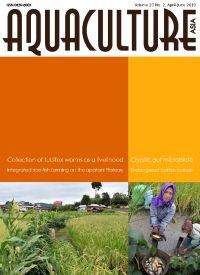The cryptic domain of gut microbiota in composite culture of Indian major carps
2 May 2019 | Biju Sam Kamalam, Vazhakkala Lyju Jose, Manchi Rajesh and Appoothy Thulasi | 1193 Downloads | .pdf | 2.15 MB | Freshwater finfish, India, Inland aquaculture, Nutrition and feeding
The digestive tract of all vertebrates including fish is known to harbour a complex microbial ecosystem with a large, diverse and dynamic collection of microorganisms. Over the course of life, these gut microbes become an integral component of the host animal with intimate host-microbe associations and key roles in the maintenance of normal gut function, physiology and health of the host.
Numerous studies have shown that fish gut is colonised by specialised microbial communities that have not been detected in the environment. Distinct relationships have been found between host diet, trophic level, the anatomy of alimentary tract and gut microbiota composition.
In Indian major carps (catla, rohu and mrigal), hitherto, culture-based identification of few aerobic and facultative anaerobic bacteria has been carried out, either based on biochemical properties or 16S rRNA gene sequence analysis of the enumerated colonies. The microbes that were isolated and genetically identified from Indian major carps belong to the genus Citrobacter sp., Enterobacter sp. and Bacillus sp. of the phyla Proteobacteria and Firmicutes. Some of the isolated microbes were demonstrated to be a distinct source of exogenous digestive enzymes for the host, apparently assisting digestive processes.
Apart from this, there is no proper information on 1) the presence of host-specific microbial populations; 2) the source or origin of the gut microflora; 3) the resident (autochthonous) and transient (allochthonous) microbial groups; and 4) the existence of symbiotic host-microbe associations and functional contributions.
Therefore, in the following study, we employed both bacterial enumeration and culture independent DNA fingerprinting (PCR-DGGE) approach to examine the presence of host-specific gut microbiota related to their occupancy of distinct ecological niches. Also, we looked at the source/origin (from water, sediment and diet) and colonising ability (resident-transient forms) of bacteria in the digestive tract of the Indian major carps.
Creative Commons Attribution.

